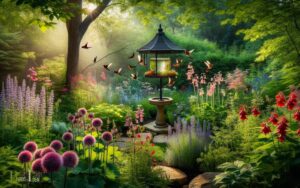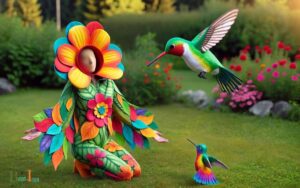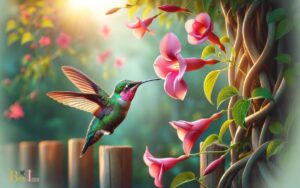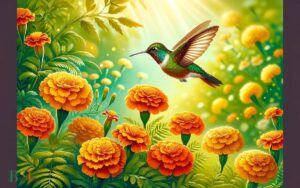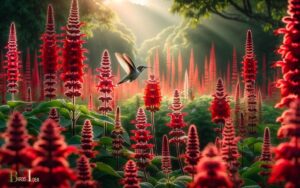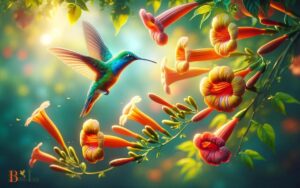What Colors Attract Hummingbirds and Butterflies? Pink!
Bright, bold colors such as red, pink, orange, purple, and yellow are known to attract hummingbirds and butterflies. These vibrant hues are like beacons to these creatures, signaling the presence of nectar.
Both hummingbirds and butterflies are drawn to areas that mimic the vivid colors of the flowers they typically feed on.
Here’s a breakdown of color preferences:
Planting a garden with a variety of these colors can create a haven for both hummingbirds and butterflies. Additionally, the use of feeders with these colors, especially red, can supplement their diet and further encourage visits.
Create a colorful oasis for winged visitors by choosing plants and feeders in hues that both hummingbirds and butterflies find irresistible.
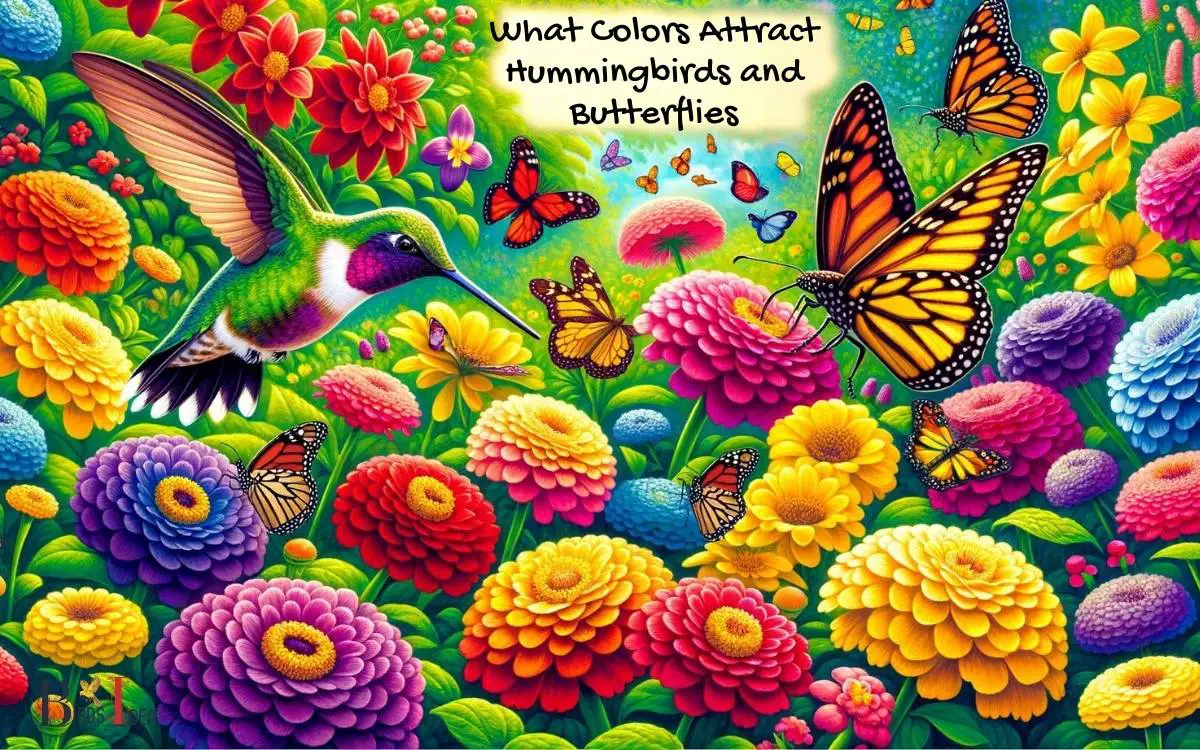
Key Takeaway
The Importance of Color in Garden Design
The selection of colors in garden design significantly influences the attraction of hummingbirds and butterflies.
These creatures are drawn to vibrant and bright colors, particularly red, orange, and pink, as these hues signal a potential food source to them.
When planning a garden to attract hummingbirds and butterflies, it’s important to incorporate flowers and plants that bloom in these colors.
For instance, flowers like bee balm, salvia, and zinnias are known to be highly attractive to hummingbirds due to their red and pink hues.
Similarly, butterflies are attracted to orange and yellow flowers such as marigolds and butterfly weed.
Understanding the preferences of these creatures and strategically incorporating these colors into garden design can significantly enhance the presence of hummingbirds and butterflies in the area.
Red: A Magnet for Hummingbirds
Red is a color that acts as a magnet for hummingbirds due to its ability to catch their attention. Research suggests that while hummingbirds are attracted to a variety of colors, they show a strong preference for red.
The impact of color on the behavior and foraging patterns of hummingbirds is a fascinating area of study that can provide valuable insights for gardeners and wildlife enthusiasts.
Red Attracts Hummingbirds
Hummingbirds are attracted to red flowers due to the rich nectar they provide. The vibrant red color acts as a signal for the presence of high-energy nectar, making it easier for hummingbirds to locate a food source.
Red also contrasts well against the green foliage, making it more visible to hummingbirds as they fly by.
Red flowers that are tubular in shape are particularly attractive to hummingbirds, as they are adapted to feed from long, tubular blossoms.
Red Flowers Attract Hummingbirds
- Rich Nectar
- Contrasts with Green Foliage
- Tubular Shape
Understanding these factors can help attract more hummingbirds to your garden by planting red flowers that provide an abundant nectar source.
Color Preferences for Hummingbirds
Color preferences for hummingbirds often focus on rich, vibrant shades that signal high-energy nectar sources.
Among these colors, red stands out as a magnet for hummingbirds. The reason behind this attraction lies in the visual capabilities of hummingbirds.
Their eyes are particularly sensitive to red hues, making them highly responsive to flowers, feeders, and other objects in this color.
Red is associated with high energy and is easily visible to hummingbirds, making it a preferred choice for attracting these tiny, energetic birds.
Gardeners and bird enthusiasts seeking to attract hummingbirds can use this knowledge to strategically place red flowers or red-colored feeders in their outdoor spaces to create an inviting environment for these delightful creatures.
Impact of Color
With its vibrant and energy-signaling hue, red serves as a magnet for hummingbirds due to their heightened sensitivity to this color.
The impact of the color red on hummingbirds can be attributed to several factors:
- Attracts Attention: Red stands out in the natural environment, making it highly visible to hummingbirds.
- Associated with Food: Many red flowers contain high amounts of nectar, making them an essential food source for hummingbirds.
- Perceived as a Food Source: The color red triggers a feeding response in hummingbirds, as they associate it with nectar.
- Enhances Mating Displays: Male hummingbirds often have red markings, using the color to attract females during courtship displays.
- Long-Distance Recognition: Hummingbirds can perceive red over long distances, making it easier for them to locate food sources and potential mates.
Understanding the impact of red on hummingbirds can help attract these fascinating creatures to gardens and natural spaces.
Blue and Purple: Irresistible to Butterflies
Butterflies are drawn to blue and purple flowers due to the wavelengths of light that these colors emit.
These colors are perceived by butterflies as particularly attractive, prompting them to visit and pollinate the flowers.
The combination of blue and purple creates an irresistible allure for butterflies, making gardens adorned with such flowers a haven for these delicate creatures.
| Blue and Purple Flowers | Emotion |
|---|---|
| Delphinium | Tranquility |
| Lavender | Serenity |
| Iris | Elegance |
The delicate and serene nature of blue and purple flowers creates an enchanting ambiance that beckons butterflies.
Understanding the preference of butterflies for these colors can inspire individuals to cultivate butterfly-friendly gardens, fostering a harmonious coexistence with these beautiful insects.
Yellow and Orange: Alluring to Both Species
Yellow and orange flowers are highly attractive to both hummingbirds and butterflies due to their vibrant hues and rich nectar content. These colors are particularly appealing because they stand out and are easily visible to these flying creatures.
Additionally, the nectar of yellow and orange flowers tends to be especially plentiful and rich in nutrients, making them irresistible to hummingbirds and butterflies.
Some specific flowers in these colors that are known to attract both species include:
- Butterfly weed (Asclepias tuberosa)
- Mexican sunflower (Tithonia diversifolia)
- Black-eyed Susan (Rudbeckia hirta)
- Orange honeysuckle (Lonicera ciliosa)
- Common zinnia (Zinnia elegans)
These flowers not only provide a visual feast with their bright colors but also offer a delectable treat in the form of their abundant nectar, making them a favorite among both hummingbirds and butterflies.
Green and Neutral Tones: Complementary Considerations
Attracting hummingbirds and butterflies, green and neutral-toned flowers offer an alternative visual and nectar-rich appeal in the garden.
While bright and vibrant colors are known to attract these pollinators, green and neutral tones provide a subtle yet complementary addition to the garden landscape.
Green flowers, often overlooked, can blend seamlessly with the surrounding foliage, creating a natural and calming aesthetic that can be appealing to both hummingbirds and butterflies.
Neutral tones such as cream, beige, and soft white can also add a sense of elegance and sophistication to the garden, attracting these beautiful creatures with their understated charm.
By incorporating green and neutral-toned flowers, gardeners can create a diverse and balanced environment that appeals to a wide range of pollinators.
When considering color options in the garden, it’s important to take into account the specific preferences of hummingbirds and butterflies.
Tips for Incorporating Color in Your Garden
Frequently, gardeners find it helpful to incorporate a variety of colors to attract hummingbirds and butterflies, enhancing the visual appeal of their garden. Here are some tips for incorporating color in your garden:
- Choose a diverse range of flowers: Select flowers in different colors to create an attractive and inviting environment for hummingbirds and butterflies.
- Consider the bloom time: Opt for plants that bloom at different times throughout the season to ensure a continuous food source for these pollinators.
- Utilize color combinations: Pair complementary colors to create visually striking displays that are irresistible to hummingbirds and butterflies.
- Incorporate foliage: Integrate plants with colorful foliage to add depth and interest to your garden while providing additional shelter and food sources.
- Use color strategically: Place plants of similar colors together to create focal points and guide the attention of hummingbirds and butterflies.
Conclusion
The use of color in garden design is like a beautiful symphony that attracts hummingbirds and butterflies.
By incorporating red, blue, purple, yellow, and orange hues, gardeners can create a mesmerizing landscape that invites these delicate creatures to dance among the flowers.
With careful consideration of color, one can create a harmonious environment that delights both the eye and the heart.

